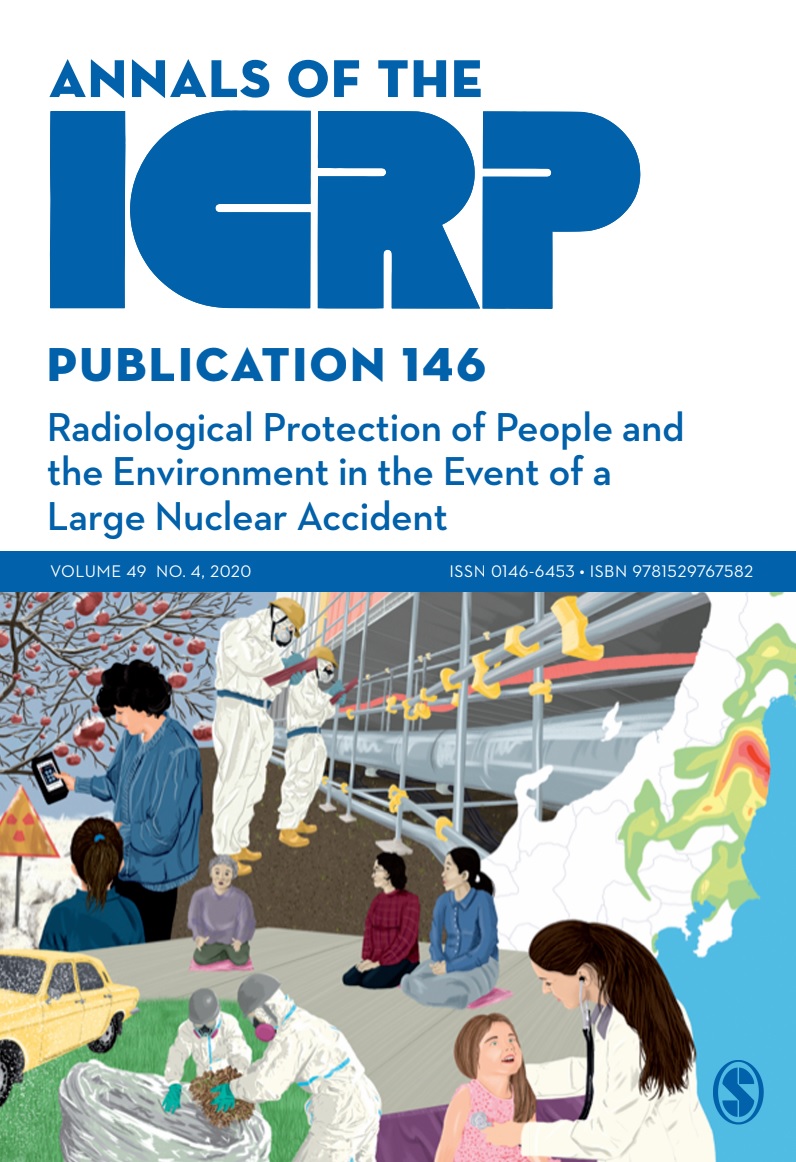Recommended citation
ICRP, 2020. Radiological protection of people and the environment in the event of a large nuclear accident: update of ICRP Publications 109 and 111. ICRP Publication 146.Ann. ICRP 49(4).
Authors on behalf of ICRP
M. Kai, T. Homma, J. Lochard, T. Schneider, J.F. Lecomte, A. Nisbet, S. Shinkarev, V. Averin, T. Lazo
Abstract - This publication provides a framework for the protection of people and the environment in a large nuclear accident, drawing on experience of the Chernobyl and Fukushima accidents. In managing accidents, the Commission makes a distinction between the early and intermediate phases, considered emergency exposure situa-tions, and the long-term phase, considered an existing exposure situation. In emergency and existing exposure situations, mitigating the radiological consequences on humans and the environment is achieved using the fundamental principles of justification of decisions and optimisation of protection. The Commission recommends a set of reference levels for the optimisation of protection of the general population and responders, both on-site and off-site, for all accident phases. Implementation of protective actions should not only take account of radiological factors, but also consider societal, environmental, and economic aspects to protect health, ensure sustainable living conditions for the affected people, ensure suitable working conditions for the responders, and maintain the quality of the environment. In the early phase of an accident, urgent protective actions have to be taken, often with little information. Decisions rely on actions identified during preparedness planning that best match the actual situation. During the intermediate phase, protective actions reduce radiation exposures progressively. When the radiological situation is sufficiently characterised, the long-term phase begins, during which further protective actions are implemented to improve living and working conditions. Authorities should invite key representative stakeholders to participate in the preparedness process, and in the management of the successive phases of the accident. It is the role of the authorities to implement radiation monitoring and health surveillance, and to provide the conditions and means for sharing information and expertise to enable individuals to develop a radiological protection culture and to make informed decisions about their own protection.
ICRP, 2020. Radiological protection of people and the environment in the event of a large nuclear accident: update of ICRP Publications 109 and 111. ICRP Publication 146.Ann. ICRP 49(4).
Authors on behalf of ICRP
M. Kai, T. Homma, J. Lochard, T. Schneider, J.F. Lecomte, A. Nisbet, S. Shinkarev, V. Averin, T. Lazo
Abstract - This publication provides a framework for the protection of people and the environment in a large nuclear accident, drawing on experience of the Chernobyl and Fukushima accidents. In managing accidents, the Commission makes a distinction between the early and intermediate phases, considered emergency exposure situa-tions, and the long-term phase, considered an existing exposure situation. In emergency and existing exposure situations, mitigating the radiological consequences on humans and the environment is achieved using the fundamental principles of justification of decisions and optimisation of protection. The Commission recommends a set of reference levels for the optimisation of protection of the general population and responders, both on-site and off-site, for all accident phases. Implementation of protective actions should not only take account of radiological factors, but also consider societal, environmental, and economic aspects to protect health, ensure sustainable living conditions for the affected people, ensure suitable working conditions for the responders, and maintain the quality of the environment. In the early phase of an accident, urgent protective actions have to be taken, often with little information. Decisions rely on actions identified during preparedness planning that best match the actual situation. During the intermediate phase, protective actions reduce radiation exposures progressively. When the radiological situation is sufficiently characterised, the long-term phase begins, during which further protective actions are implemented to improve living and working conditions. Authorities should invite key representative stakeholders to participate in the preparedness process, and in the management of the successive phases of the accident. It is the role of the authorities to implement radiation monitoring and health surveillance, and to provide the conditions and means for sharing information and expertise to enable individuals to develop a radiological protection culture and to make informed decisions about their own protection.
Given the significant concern about military action around the Zaporizhzhia nuclear power plant, and the possibility of similar activity around other NPPs in Ukraine, the International Commission on Radiological Protection (ICRP), in partnership with SAGE publishing UK, has made ICRP Publication 146 Radiological Protection of People and the Environment in the Event of a Large Nuclear Accident immediately free to access. Although this publication was not specifically intended to cover radioactive releases due to military action, the principles and guidance provided should be helpful should such an unfortunate event occur. We hope this helps those responsible for planning the response to a large nuclear accident to be better prepared, and that it will not be necessary to put these plans into action. (23 August 2022)
Download PDF
日本語 (Japanese)
한국어 (Korean)
Preliminary Japanese Translation of excerpts from ICRP Publication 146
Resolution of Comments
Resolution of Comments (Japanese)
Translations
Français (French)日本語 (Japanese)
한국어 (Korean)
Other Resources
Free Excerpt from ICRP Publication 146Preliminary Japanese Translation of excerpts from ICRP Publication 146
You may also be interested in
ICRU Report 92, Radiation Monitoring for Protection of the Public after Major Releases of Radionuclides to the EnvironmentResolution of Comments
Resolution of Comments (Japanese)
